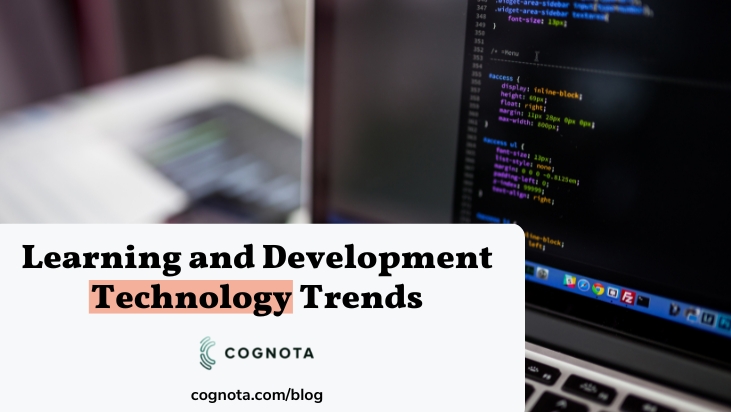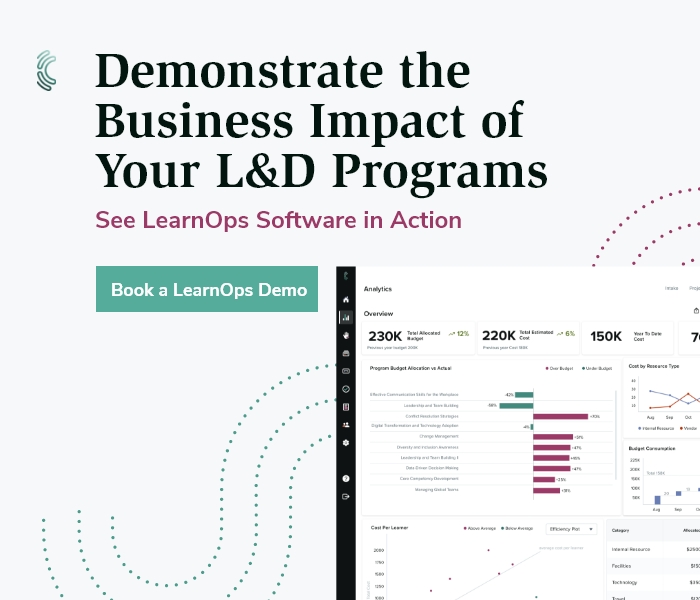Training expenditures passed the $100 billion-mark for the first time in 2021-2022, according to Training magazine’s 2022 Training Industry Report. While this figure includes facilities, equipment, and salaries, technology spend was also a large portion of this. The magazine found that on average, organizations spent 16 percent of their budget or $382,729 (up from $337,190 last year) on learning tools and technologies.
The use of technology to rapidly generate content, distribute at scale, and measure success will continue to be a focus for L&D leaders. Technology in learning and development is closely linked to the organization’s eLearning strategy, or the plan for leveraging devices, software, and networks to improve individual employee competencies, skills, and knowledge.
An eLearning strategy is also part of the overall learning and development strategy that the organization should already have in place. These can include not only technologies but also processes, policies, protocols, and objectives set forth by the firm’s senior management to manage learning initiatives and track success.
7 Technology Trends Set to Shape the Future of L&D
Many of the tools and technologies on this list might be familiar to L&D teams, and their use might already be well underway. However, it’s helpful to understand how the use cases for some technologies may have shifted, as needs change.
1. LearnOps Technology:
As developing and distributing learning becomes more complex, and handled by disparate contributors, designers, developers, and managers across an organization, solutions are needed to unlock operational inefficiencies to produce better outcomes. LearnOps is a platform that enables the training function to move from cost center to performance driver, leaning on data to track learning measurement and tie results back to business performance. See LearnOps software in action for yourself.
2. Artificial Intelligence and Machine Learning
AI and ML are being used to personalize learning and provide real-time feedback to learners. AI can be used to create individualized, personalized programs for learners. Known as adaptive learning, the technology leverages AI and algorithms to adjust the learning experience based on a learner’s performance, interests, and needs. AI can also be utilized to rapidly generate content, supporting the efforts of instructional designers and content developers needing to build courses at scale.
3. Gamification
Gamification is the use of game design elements in non-game contexts. While it can be used to make learning more engaging, relatable (especially for younger employees), and enjoyable, there are risks in making learning too much like a videogame that learners will not take seriously. Learning leaders should understand the preferences of their learning audience first before adding gamification features, which can often be costly and time-consuming because of the developer hours needed.
4. Virtual and Augmented Reality
VR and AR technologies can provide immersive and interactive learning experiences. VR/AR technologies can deliver a “you are there”-type experience without incurring traveling expenses, while ensuring that the learner is 100% focused on learning without distraction.
5. Microlearning
Microlearning involves delivering small, bite-sized pieces of information to learners, which has become increasingly popular as people’s attention spans shorten. Microlearning is also perfect for learning on the go, as employees can access short learning modules or even take assessments while on mobile devices.
6. Social and Collaborative Learning
Social and collaborative learning technologies connect learners in order to facilitate peer-to-peer learning. Collaboration is nothing new, but collaborating for the purpose of learning from one’s peers is growing in interest, as subject matter experts can be anywhere and people need to learn in the moment of need.
7. Video-Based Learning
Video-based learning is also nothing new. However, the way in which it is delivered is evolving and adapting to learners’ needs..Video can be delivered as smaller microlearning modules (see above), or can be used for assessments, in which the learner must record themselves responding to questions or role-playing certain scenarios.
How can L&D leverage these technology trends?
Given so many technologies are available for the development of learning content, it’s helpful to understand the use cases or specific examples where L&D teams can see success by incorporating each of these.
Learning and development can leverage these new technology trends in the following ways:
LearnOps
A LearnOps platform will reduce friction among project stakeholders, deliver clearer visibility into resource leaks (such as time and budget) to reduce strain, and improve experiences and outcomes for all.
Artificial Intelligence and Machine Learning
Through personalized learning programs, AI and ML can ensure that learners are focused and engaged. AI writing tools, such as those provided by ChatGPT, can greatly assist developers and designers by generating content rapidly and at scale.
Gamification
Examples of gamification elements can be anything from digital points and leaderboards to video game-like graphics where employees assume the identities of characters and role-play scenarios, such as a sales meeting.
Virtual and Augmented Reality
By providing a distraction-free experience, VR and AR can provide learners with immersive and interactive learning that can help them better retain information and understand complex concepts.
Microlearning
Microlearning can help learners access information quickly and efficiently, making it easier for them to fit learning into their busy schedules. Courses should be device and platform agnostic so that courses can be accessed wherever and whenever learners wish to learn.
Social and Collaborative Learning
Social and collaborative learning technologies can help connect learners and facilitate peer-to-peer learning, creating a more dynamic and engaging learning experience. Instead of using basic tools like Zoom or screen capture software, a social or collaborative learning platform is built for learning, and can enable a subject matter expert or manager to provide instruction to individuals or teams whenever needed.
Video-Based Learning
Video-based learning can provide learners with more engaging and accessible content and lessons, helping to increase their understanding and retention of information. As noted above, video-based learning is not new but how it is used continues to evolve. Video instruction can be live, in real-time with live attendees; it can also be recorded and accessed at a later date. Tools can be used to annotate the video; learners can stop and click links along the way for a multi-touchpoint learning experience.
By leveraging these technology trends, learning and development professionals can create more effective and engaging learning experiences for their learners.
Business benefits of leveraging technology in learning and development
Beyond simply enabling “distance learning,” technology applied to learning and development initiatives delivers innumerable benefits to both the learner and the organization as a whole.
Increased Productivity
By using technology to streamline and automate certain aspects of learning and development, organizations can increase their overall productivity and efficiency.
“In today’s skills-based economy, people want to learn faster than ever,” notes HR consultant Josh Bersin, and the most effective learning is “designed to be ‘in the flow of work,’ so you can learn where you are, when you have time, and when you need the help.”
Improved retention and engagement
Technology-enhanced learning experiences can be more engaging and interactive, which can lead to better retention of information and higher levels of learner engagement.
According to Training magazine, employees receive on average only 62.4 hours of training per year, which comes to a little over one hour per week. Higher engagement via L&D technologies ensures that learners make the most use of the precious little time they have.
Scalability and accessibility
Technology enables organizations to deliver training to a large number of employees quickly and consistently, regardless of the employee’s location, device, platform, or operating system.
The cost of developing training is a perennial headache for learning leaders. Enabling training to be deployed to the largest employee audience possible justifies development costs and improves the ROI of L&D efforts.
Stronger collaboration and knowledge sharing
Technology can facilitate collaboration and knowledge sharing among employees, leading to a more connected and informed workforce and creating a culture of learning.
Deeper insights
Data and analytics tools can provide organizations with valuable insights into the effectiveness of their learning and development programs, allowing them to make stronger, data-driven decisions.
Competitive advantage
By leveraging the latest technology trends in learning and development, organizations can differentiate themselves from competitors and gain a competitive advantage in the market.
By leveraging these technology trends, organizations can create more effective and efficient learning and development programs that meet the needs of today’s hybrid workplaces while driving business results and improving overall performance.
Bring it all together with LearnOps®
As the first and only operations platform built specifically for L&D teams and their processes, Cognota’s LearnOps platform brings your entire workflow from intake to planning and design into one platform. You’ll get data on training demand and coverage throughout the organization and insights into your team’s capacity and workload. Plus, you can connect all the learning and business tools you already use and love through an extensive library of integrations. Get started for free or speak with our sales team to learn more or book a personalized demo.







